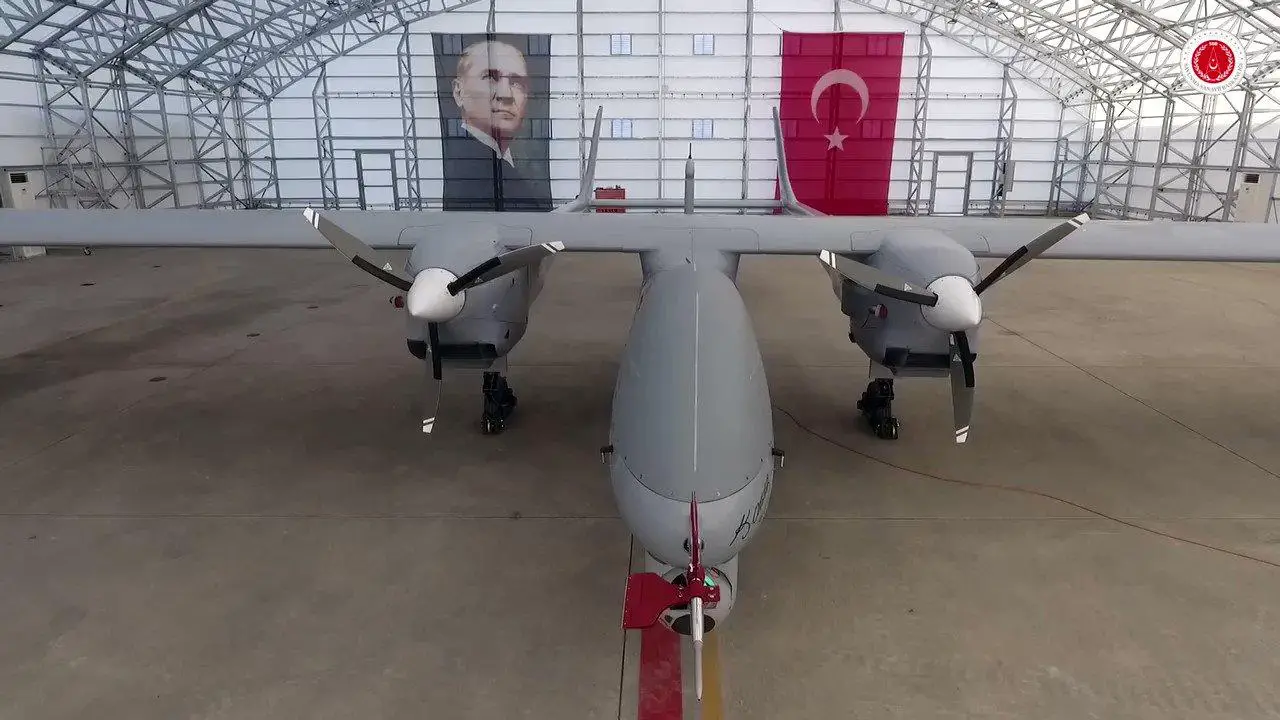Turkish Aerospace Industries (TAI) delivered the third Aksungur unmanned combat aerial vehicle to the Turkish Navy on August 04, 2022. The Turkish Navy acquired its first Aksungur UCAV on 20 October 2021, and the second one 28 March 2022. After delivery, the drone inventory of the Turkish Navy increased to 21, three Aksungur UCAVs, ten TB2-BAYRAKTAR UCAVs, four ANKA-S UAVs, and four ANKA-B UAVs. The TAI Aksungur is an unmanned aerial vehicle (UAV) built by Turkish Aerospace Industries (TAI) for the Turkish Armed Forces. Using existing technology from the TAI Anka series of drones, it is the manufacturer’s largest drone with payload capacity for mission-specific equipment. It is intended to be used for long-term surveillance, signals intelligence, maritime patrol missions, or as an unmanned combat aerial vehicle.
The aircraft is 12 m (39 ft) long and 3 m (9.8 ft) high when resting on its landing gear. The high-mounted wings have a slight dihedral angle and a wingspan of 24 m (79 ft).[1] The wings end with small winglets. The centralized fuselage is under the wings and houses avionics, camera and sensors systems, with a chin-mounted camera blister. Fuel is stored in the fuselage and wings. A turbocharged engine is mounted under each wing, with the engine nacelles each extending backward into a tail boom. These tail booms terminate in vertical stabilizers, with a horizontal tailplane joining them. The tricycle landing gear retracts into the engine nacelles and the nose of the aircraft while in flight.

The TAI Aksungur is powered by two forward-mounted PD-170 dual-turbocharged diesel engines developed by Tusa? Engine Industries (TEI), equipped with three-bladed propellers in a tractor (puller) configuration. According to the manufacturer, these enable the Aksungur to cruise at a maximum speed of 180 km/h (110 mph) and carry a maximum payload of 750 kg (1,650 lb) to an altitude of 25,000 ft (7,600 m), or ascend to 35,000 ft (11,000 m) with a 150 kg (330 lb) payload. The aircraft’s designed maximum payload is 375% greater than that of its predecessor; its maximum takeoff weight is 3,300 kg (7,300 lb). It is rated to stay aloft 12 hours as an attack aircraft or maritime patrol aircraft and 24 hours during signals intelligence missions.
Remote control of the UAV is performed by DO-178B compatible software on DO-254 compatible ground control station and hardware using double backed-up encrypted digital data link. Optional beyond-visual-range operation flexibility is available via communications satellite. TAI expects to integrate weapon systems typical of F-4 and F-16 fighter aircraft onto Aksungur in the last quarter of 2019. Three hardpoints are situated under each wing for attaching external payloads, such as munitions or sonar buoys. These hardpoints are rated for loads of 150, 300 and 500 kg (330, 660 and 1,100 lb). Proposed armaments include TEBER-81 (laser-guided bomb Mk-81), TEBER-82 (laser-guided bomb Mk-82), LUMTAS, MAM-L, Roketsan Cirit, MAM-C, HGK-3 (precision-guided munition), KGK (82) (winged guided kit), and miniature bomb.
Teslimatlar?m?z? sürdürüyoruz.
Son olarak #AKSUNGUR S?HA’dan 1 adet daha Deniz Kuvvetleri Komutanl???m?za teslim ettik.????
S?HA'lar?m?z Mavi Vatan'da göreve her daim haz?r! Hay?rl? olsun.
?? @TUSAS_TR #?stiklâlve?stikbâlimiz?çin pic.twitter.com/qLZ7BsWRQe
— Ismail Demir (@IsmailDemirSSB) August 4, 2022















